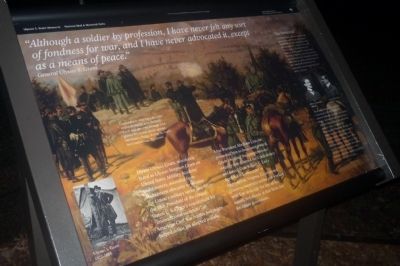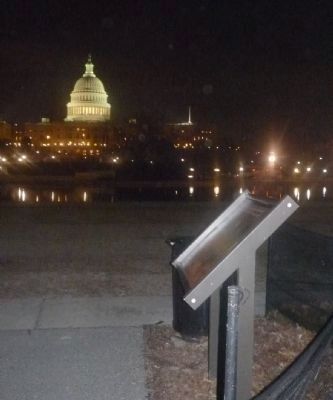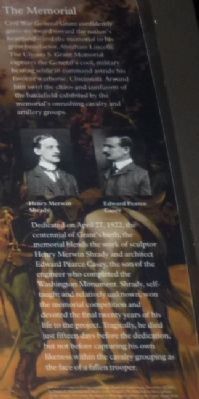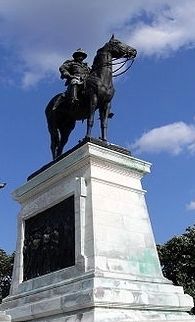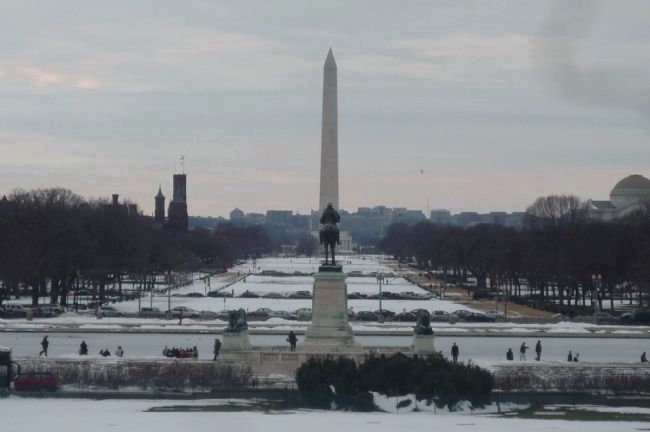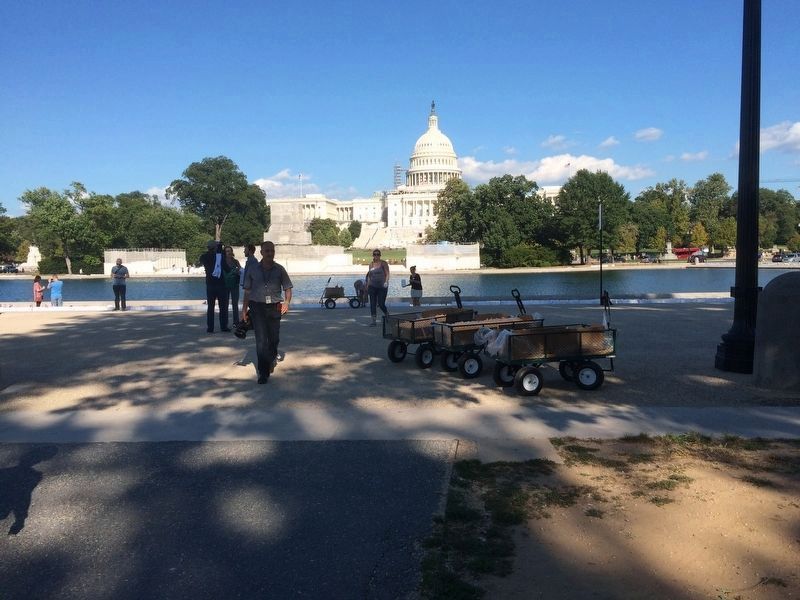Capitol Hill in Southwest Washington in Washington, District of Columbia — The American Northeast (Mid-Atlantic)
Ulysses S. Grant Memorial
National Mall and Memorial Parks
ó National Park Service, U.S. Department of the Interior ó
“Although a soldier by profession, I have never felt any sort of fondness for war, and I have never advocated it, except as a means of peace,”
General Ulysses S. Grant.
Hiram Ulysses Grant, mistakenly listed as Ulysses Simpson Grant on United States Military Academy cadet rosters, ascended from Midwestern obscurity to become the Unionís military savior and, later, the 18th President of the United States. U.S. Grantís requirement for “unconditional surrender” in American Civil War battles and sieges helped define his adopted initials.
After President Abraham Lincoln promoted him to lieutenant general, Grant designed the comprehensive strategy that doomed Confederacy and forced Gen. Robert E. Leeís April 9, 1865, surrender at Appomattox, Virginia. Grant issued generous surrender terms and worked with Lee to decide the fate of this nation, not merely at that hour, but for future generations.
[Caption describing background painting:] Grant (above, wearing a sky blue overcoat) stands atop Orchard Knob and observes through field glasses the Union attack against Missionary Ridge, during the battle for Chattanooga, Tennessee.
[ Sidebar:] The Memorial
Civil War General Grant confidently gazes westward toward the nationís heartland–and the memorial to his great benefactor, Abraham Lincoln. The Ulysses S. Grant Memorial captures the Generalís cool, military bearing while in command astride his favorite warhorse, Cincinnati. Around him swirl the chaos and confusion of the battlefield exhibited by the memorialís onrushing cavalry and artillery groups.
Dedicated on April 27, 1922, the centennial of Grantís birth, the memorial blends the work of sculptor Henry Merwin Shrady and architect Edward Pearce Casey, the son of the engineer who completed the Washington Monument. Shrady, self-taught and relatively unknown, won the memorial competition and devoted the final twenty years of his life to the project. Tragically, he died just fifteen days before the dedication, but not before capturing his own likeness within the cavalry grouping as the face of a fallen trooper.
Erected 2009 by National Park Service, U.S. Department of the Interior.
Topics and series. This historical marker and memorial is listed in these topic lists: Government & Politics • Heroes • Military • War, US Civil. In addition, it is included in the Former U.S. Presidents: #16 Abraham Lincoln, and the Former U.S. Presidents: #18 Ulysses S. Grant series lists. A significant historical date for this entry is April 9, 1882.
Location. Marker has been reported missing.
It was located near 38° 53.319′ N, 77° 0.863′ W. Marker was in Southwest Washington in Washington, District of Columbia. It was in Capitol Hill. Marker was on 3rd Street Southwest north of Maryland Avenue Southwest, on the right when traveling north. Marker is in Union Square at the east end of the Mall, in the grass off the walkway near the southwest corner of the Capitol Reflecting Pool. It is north of Maryland Avenue Southwest (open to vehicles with government permits, only) and east of the intersection with 3rd Street and Jefferson Drive. Touch for map. Marker was at or near this postal address: 158 Maryland Avenue Southwest, Washington DC 20204, United States of America. Touch for directions.
Other nearby markers. At least 8 other markers are within walking distance of this location. The National Garden Takes Root (within shouting distance of this marker); Potato Farm and Machu Picchu (within shouting distance of this marker); Onion Farm (about 300 feet away, measured in a direct line); Cranberry Bog (about 300 feet away); What Kind of Rose Is That? (about 300 feet away); Cardinal Direction Marker: East (about 400 feet away); National Native American Veterans Memorial (about 400 feet away); George Rivera (about 500 feet away). Touch for a list and map of all markers in Southwest Washington.
More about this memorial. [ Footnote:] Library of Congress (background image, Battle of Chattanooga , November 25,
1863, by Thure de Thadstrup and photo credit, Shrady); The National Archives (photo credit, Grant); The Grant Memorial in Washington (photo credit, Casey image from The Grant Memorial in Washington by The Grant Memorial Commission, 1924).
Related markers. Click here for a list of markers that are related to this marker. To better understand the relationship, study each marker in the order shown.
Also see . . .
1. Ulysses S. Grant Memorial. (Submitted on January 23, 2010, by Richard E. Miller of Oxon Hill, Maryland.)
2. Ulysses S. Grant Memorial Restoration. (Submitted on December 12, 2017, by Devry Becker Jones of Washington, District of Columbia.)
Additional keywords. Reconstruction
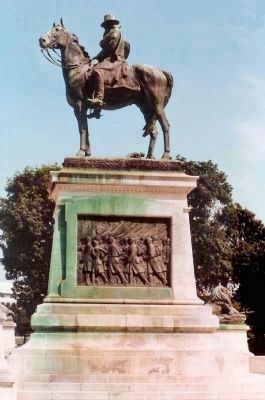
Photographed By Mike Stroud, circa 1998
6. Ulysses S. Grant Memorial
Equestrian statue of Grant: approx. 17 ft. 2 in. x 8 ft. x 4 ft.; Base: approx. 22 1/2 ft. x 6 ft. 4 ft.; Platform: approx. W. 252 ft. D. 71 ft. (10,700 lbs.).
by Vermont Marble Company;the figure of Grant, dressed in his military uniform and slouch hat, seated astride his charger, Cincinnatus; Soldiers carrying flags and rifles march in profile.
(SIRIS, Smithsonian Institution Research Information System,) Inventories of American Painting and Sculpture, Smithsonian American Art Museum, Number IAS 77003157
(SIRIS, Smithsonian Institution Research Information System,) Inventories of American Painting and Sculpture, Smithsonian American Art Museum, Number IAS 77003157
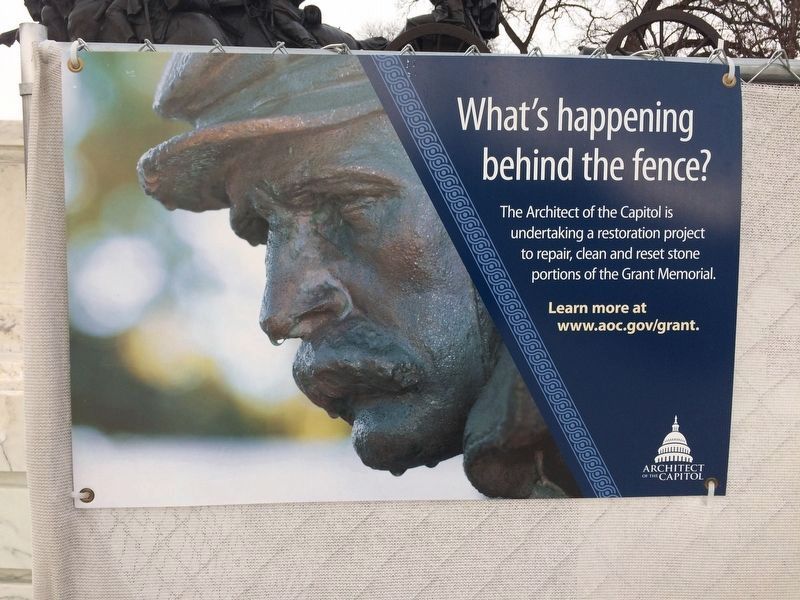
Photographed By Devry Becker Jones (CC0), December 12, 2017
8. Sign describing restoration of the Grant Memorial
What's happening behind the fence?
The Architect of the Capitol is undertaking a restoration project to repair, clean and reset stone portions of the Grant Memorial.
Learn more at www.aoc.gov/grant.
Architect of the Capitol
Credits. This page was last revised on January 30, 2023. It was originally submitted on January 23, 2010, by Richard E. Miller of Oxon Hill, Maryland. This page has been viewed 2,317 times since then and 68 times this year. Last updated on April 4, 2010, by Richard E. Miller of Oxon Hill, Maryland. Photos: 1, 2, 3, 4. submitted on January 23, 2010, by Richard E. Miller of Oxon Hill, Maryland. 5. submitted on February 25, 2010, by Richard E. Miller of Oxon Hill, Maryland. 6. submitted on January 23, 2010, by Mike Stroud of Bluffton, South Carolina. 7. submitted on September 13, 2016, by J. Makali Bruton of Accra, Ghana. 8. submitted on December 12, 2017, by Devry Becker Jones of Washington, District of Columbia. • Craig Swain was the editor who published this page.
